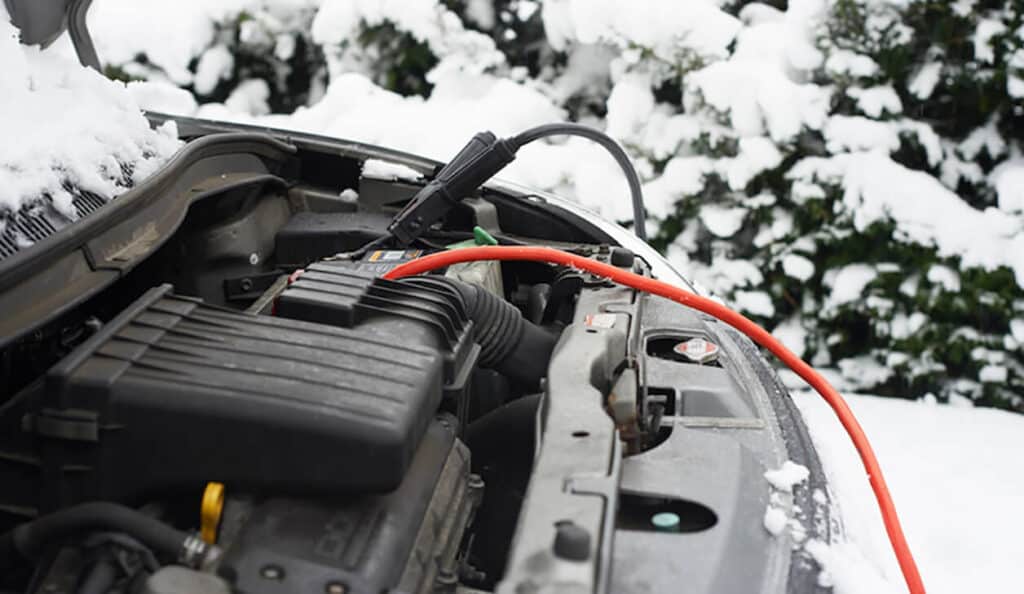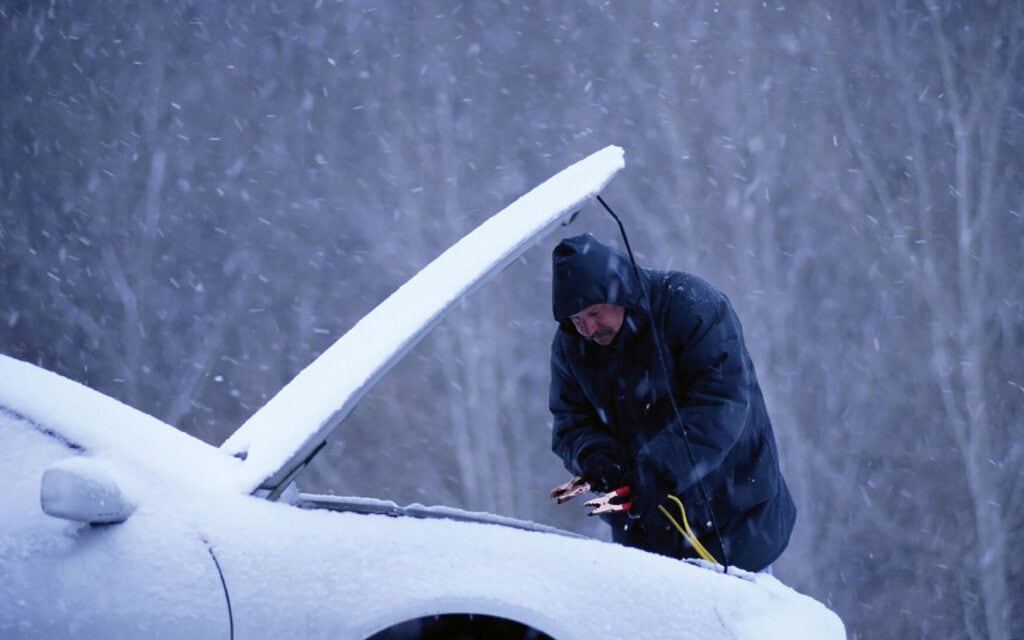Introduction: The Winter Challenge: How Cold Weather Affects Car Batteries
Cold weather can be an uninvited challenge to your car’s battery, making the journey from the comfort of your home to your daily commitments more daunting. When temperatures plummet, your battery has to work harder, which can result in reduced capacity and sometimes, failure. But don’t let winter win! Read on to find out how to keep your battery in peak condition when the mercury drops.
Understanding Cold Weather’s Impact on Car Batteries
Cold weather can have a chilling effect on car batteries, but what’s happening beneath the surface? In freezing temperatures, the chemical reactions that take place within a battery slow down, resulting in a reduction in its capacity. This can make starting your car a real struggle, especially on those icy mornings when everything seems to take that little bit longer. The lubricating oil inside the engine becomes thicker, requiring more energy to turn the engine over, all while the battery’s efficiency is compromised.
Understanding this impact is not just about knowing what’s happening; it’s about taking action. Implementing protective measures such as using a battery blanket, ensuring proper charge levels, or even storing the vehicle indoors when not in use can mitigate these effects. By acknowledging the vulnerabilities of a battery in cold weather, you can take steps to ensure its longevity and dependable performance. Knowledge paired with action equals a warm start on a cold day.

Battery Blankets: Are They Worth the Investment?
If you’re facing freezing temperatures, a battery blanket could be a savvy investment. These specialized insulators act like a warm jacket for your battery, retaining its heat and protecting it from the harsh cold. In the battle against winter’s icy grip, a battery blanket can be an effective tool to preserve your battery’s health.
Battery blankets wrap around the battery, providing a thermal barrier. This insulation helps in maintaining the optimal temperature for the battery’s chemical reactions to occur. By preventing the cold from affecting the battery, it ensures reliable performance and extends the battery’s life. Especially in regions where extreme cold is common, investing in a battery blanket can be a small price to pay for peace of mind and uninterrupted vehicle usage.
Using a Battery Blanket Overnight: Precautions and Guidelines
• Understanding the Function: A battery blanket is designed to wrap around the battery, keeping it warm and maintaining its optimal performance during cold nights.
• Overnight Use: Can you leave a battery blanket plugged in overnight? Most battery blankets are designed for continuous use, making overnight usage a common practice.
• Manufacturer’s Guidelines: However, it’s essential to read the manufacturer’s instructions and follow them closely. This ensures that you are using the battery blanket according to its design, preventing potential problems such as overheating.
• Monitoring Temperature: Some battery blankets come with thermostats or temperature controls. Utilizing these features can help maintain the correct temperature and prevent overheating.
• Avoiding Common Mistakes: Make sure the blanket is properly positioned and securely fastened around the battery. Incorrect placement can lead to inefficient heating or even damage to the battery and surrounding components.
• Compatibility Check: Ensure that the battery blanket is suitable for your specific battery type and vehicle model. Compatibility ensures efficient operation.
• Electrical Precautions: Always check the electrical connections and cords for any signs of wear or damage. Using a damaged battery blanket can lead to electrical issues or fire hazards.
• Professional Insight: If you’re unsure about using a battery blanket or need assistance in selecting the right one, professional help like that offered by Uchaincs in Canada can be valuable. Their expert advice can guide you to the right product and help you use it safely.
• Benefits of Proper Use: When used correctly, a battery blanket can enhance your battery’s lifespan and performance during winter, making those chilly morning starts much more bearable.
Taking these precautions and guidelines into account can help you get the most out of your battery blanket, ensuring optimal performance without risk, even on the coldest nights.
Alternatives to Block Heaters: Finding the Right Solution for Your Car
Engine block heaters are commonly used to warm the engine’s coolant, ensuring a smoother start in cold weather. However, they’re not the only options available, and some drivers may seek alternatives for various reasons, such as cost or vehicle compatibility. The primary goal of these alternatives is to aid in starting the engine during frigid temperatures and maintaining vehicle performance.
Circulating heaters, unlike block heaters that focus on a specific area, heat and circulate the engine’s coolant. This ensures even heating of the engine, providing an overall warmer start. By maintaining a consistent temperature throughout the engine, circulating heaters can reduce wear on engine parts and provide more efficient fuel consumption.
Another alternative is oil pan heaters, which target the engine oil directly, rather than the coolant. By warming the oil, they reduce the viscosity and allow it to flow more freely during cold starts. These can be a simple and effective solution, particularly for older vehicles or those used in extremely cold environments.
Focusing on the battery rather than the engine, battery warmers can also be part of a comprehensive cold weather strategy. By maintaining the battery temperature, they can ensure sufficient power for starting the engine. These warmers are beneficial for those living in regions where temperatures drop significantly.
Inlet air heaters are yet another alternative. These heaters warm the air entering the engine, aiding in fuel atomization. They can be a more energy-efficient option and are often used in diesel engines, providing a more efficient start in cold conditions.
Choosing the right alternative involves considering the severity and duration of cold weather in your location. In milder winter conditions, a less-intensive solution might suffice. The make, model, and age of the vehicle might necessitate specific heating options. Some solutions may be more cost-effective than others, and considering your budget is essential. It’s worth considering the energy efficiency and environmental impact of different heating options, especially if this is a priority for you.

Trickle Chargers in the Cold: Enhancing Battery Life During Winter
The Lifesaver in Winter: Will a trickle charger help in cold weather? Absolutely! When the temperature drops, batteries can lose charge faster, and starting your car becomes a battle. Trickle chargers can be your battery’s best friend during these cold months. They provide a continuous but slow charge, keeping the battery at optimal levels.
How They Work: Trickle chargers operate by delivering a low, consistent flow of electricity to your battery. They recognize when your battery’s charge drops and replenish it as needed, preventing the battery from becoming completely depleted.
When to Use: Trickle chargers are especially handy if your vehicle is parked for extended periods during winter. Whether you’re on vacation or simply don’t use your car daily, a trickle charger can ensure that your vehicle is ready to go when you are.
Selecting the Right One: It’s essential to choose a trickle charger that’s compatible with your battery type and vehicle. Consulting with a professional or reading your vehicle’s manual can guide you to the right choice.
Temperature Tolerance: What Temperature Can Kill a Car Battery?
The Freezing Point: Extreme cold can be fatal. Typically, temperatures around -40 degrees Celsius can cause permanent damage to a standard battery. The electrolyte can freeze, leading to irreversible damage.
Factors Affecting Resilience: The resilience to cold can vary based on the battery type, age, and quality. Newer or specially designed cold-resistant batteries may fare better in freezing temperatures.
Preventative Measures: Knowing your battery’s limits and taking preventative measures is key to winter survival. Regular checks, proper insulation, and avoiding prolonged exposure to extreme cold can make all the difference.
Professional Assistance: If you’re unsure about your battery’s cold-weather performance, getting professional help is wise. Mobile mechanic services in Canada can assess your battery and provide tailored solutions to ensure it withstands the winter without a hitch.
Conclusion: Staying Charged in the Chill
Winter’s chill can be a formidable opponent for your car, but with the right tools, knowledge, and strategies, you can ensure that your vehicle’s battery stays strong and reliable. From understanding the impact of cold weather on your battery to investing in battery blankets, trickle chargers, or alternatives to block heaters, you have various options to win this seasonal battle. And if you need professional insight or assistance, Uchaincs, a mobile mechanic company in Canada, is just a call away. With tailored solutions and expert advice, they can help you make the right choices for your vehicle and keep you on the road all winter long. Book an appointment with Uchaincs and take the first step towards stress-free winter driving.
